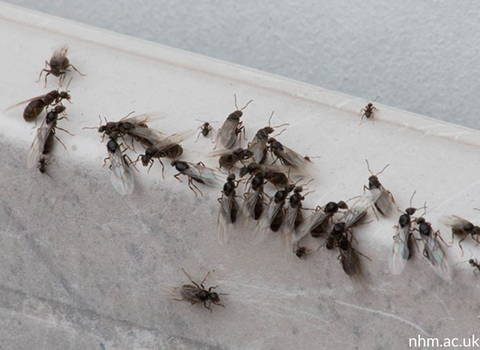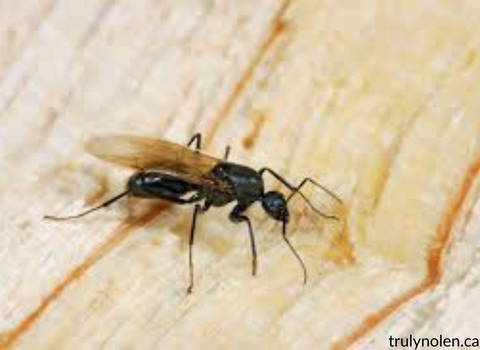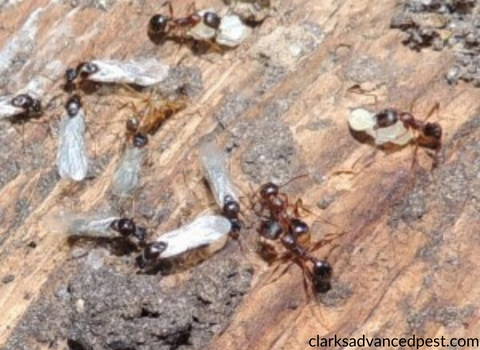What are These Ants with Wings in My House?
Ants do not just crawl. These insects can also fly, so do not be surprised if you find flying ants in your house. Ants may enter your house in search of a nesting habitat or food. Even food crumbs can attract ants, so you should keep your home clean.
What Does it Mean to Find Ants with Wings?
The flying ant’s location is essential. If you called a pest control company, they would ask you where you found the ant or where these insects swarm. For instance, if you saw flying ants on your ceiling and crawling around inside the house, these insects probably came from inside the walls. You are most likely facing a carpenter ant infestation.
A few swarming flying ants may not be a big problem, but you should still investigate it. Swarming ants are made by established colonies. This means that there could be carpenter ants in your home, and you may not even be aware of it. If you spot flying insects, you should be able to tell a winged termite and flying carpenter apart.
Termites can fly too. Some people can’t tell the differences between carpenter ants and termites, but a trustworthy pest control company can do it. If the flying insects have a waist, you’re most likely dealing with carpenter ants.
Characteristics of Carpenter Ants
Carpenter ants create can cause a lot of damage to your home. The swarmers are reddish brown or black and bigger than 3.4 mm. Aside from creating holes through your home and weakening structures, carpenters can damage the beams holding your floors together.
When Do Winged Ants Appear?
Early spring is mating season, so do not be surprised if you see more flying ants than usual during this time. According to an article that was published in Calgary Herald, carpenter ants mated early in 2016 but they could do it again at some point. Their wings fall off after mating and when it does, they will crawl again. So, if there are flying and crawling ants in your home, you might be dealing with a carpenter ant infestation.
Carpenter Ants are Destructive Pests
Many people do not realize the destructive these pests can be. Carpenter ants are a prevalent problem in Canada and the government has warned the public about these pests. Carpenter ants are known for damaging window sills, wooden steps, structural timbers, walls, and the trim of buildings.
These pests can hide behind drawers, wall voids, in Styrofoam insulation, and libraries. They can also find diverse ways to enter your abode, including heating ducts, tree branches that are touching your house, air vents, holes in the foundation, open windows, and utility wires. When they cannot find food outside, they will enter your home in search of food or a warm, comfortable place to build their nests. If you do not get rid of them quickly, they will cause structural damage to your home.
How to Get Rid of Carpenter Ants
If you saw flying ants and other signs of a carpenter ant problem, you should call pest management professionals as soon as possible. They will come to your home and assess the extensiveness and severity of the problem. After identifying the entry points and nests, they will create a treatment plan to get rid of the ants. Look for a trusted professional in the pest control industry to solve your problem.
Some products we recommend to get rid of carpenter ants are:
What are Winged Ants?
Winged ants are those capable of reproducing. Most ants are infertile and thus, cannot reproduce. On the other hand, worker ants are sterile females. The queen ant is the only female capable of reproducing. Male ants or drones exist only to fertilize the queen ant and usually die within 2 weeks of mating. Once the fertilized queen finds a nesting place, she drops her wings. These wings will become food sources for the queen as she builds her new colony.
How to Eliminate Flying Ants
It is important to manage the carpenter ant problem immediately. Whether it is a full-sized or handheld vacuum cleaner that has a hose attachment, you cannot eliminate swarms with this tool. You have to dispose of the vacuum bag outside to prevent the ants from entering your home.
Another option is to use spray pesticides to kill flying and crawling ants. However, spray pesticides will only kill visible ants. It will not affect hidden colonies, which will continue producing more ants unless it is eliminated.
If you do not want to use commercial pest treatments, you can make a homemade version by combining peppermint oil (a few drops), water (two parts) and dish soap (one part). Transfer the mixture into a spray bottle and spray the visible ants as well as surrounding areas. The peppermint oil will suffocate the ants, while the soap dehydrates them.
Get Rid of the Colonies
You will not be able to eliminate the ants unless you get rid of their colonies where they are breeding. Carpenter ants build two nests – the parent nest that houses the egg-laying queen, worker ants, and brood and the satellite colonies that contain the eggs, young and mature larvae, and other ants. The ants inside your home may have come from satellite nests or main nests.
Placing Ant Baits
You can set ant bait to address the colonies. Ant bait is usually a sweet substance that contains borax or other substances that disrupt the reproduction cycle of the ants. They will take the bait back to the nest where it will kill the entire colony.
Injecting Insecticidal Dust
You can also inject insecticidal dust into the areas where you found them. Read the pesticide label and follow the manufacturer’s directions on how to use it. According to the University of Minnesota Extension, the best way to control carpenter ants is to inject insecticides into their nests. Since controlling these pests is a complex matter, it is best to entrust the job to a pest control technician or pest management professional.
Replacing Damaged Wood
Did you see swarms of winged ants inside your homes during the winter? If yes, there is a good chance that there are carpenter nests in your home. Like termites, carpenter ants can cause structural damage. Since flying carpenter ants are bigger than house ants, it is easy to recognize them.
Carpenter ants have an evenly rounded and a waist with petiole or one node. Worker carpenter ants are red and black or black and usually 3/8" to 1/2"long. Some ant species are bigger. Black carpenter ants are the most common species. Males and queens are winged and bigger than worker ants. Queens shed their wings when they build a new nest.
Differences of Carpenter Ants from Termites
Carpenter ants are also easy to differentiate from termites at first glance. Worker termites have light-coloured bodies, straight antennae, and broad waists. Termites also rarely come out of their colonies, so you may not even see them carrying food back to their nest. The wings of winged males and queen termites are of equal length. They are also dark-coloured.
Unlike termites, carpenter ants have narrow waists, dark colored bodies, and bent or elbowed antennae. Their hind wings are also shorter compared to the front wings. Moreover, they do not eat wood. Correct ant identification is crucial for control treatments to work effectively. That way, you can identify whether you are dealing with termites or simply ants.
If you are dealing with carpenter ants, you should replace and remove any decaying or rotten wood under the flows or in the walls because this material fosters the colony. Extensive ant problems will require the service of a professional contractor. However, the best way to get rid of these pests is to remove the decayed wood where you found them and replace it with sound wood. You should also store firewood in a dry place.
How to Recognize a Carpenter Ant Infestation
Even if you found winged carpenter ants inside your house during summer, it does not mean that there is a nest in your abode. Carpenter cants can nest in the old stump and hollow trees. If you have not seen ants inside your home during winter, there is probably nothing to worry about.
Indoor Nests
Carpenter ants that nest indoors prefer punky and wet wood such as drains and leaky pipes, but they can also stay in dry places like false beams and hollow doors. But if you have seen them during late fall, early spring, and winter, it is a sign that there is a nest inside your home.
When carpenter ants nest indoors, they usually stay in enclosed areas with damp or wet wood. Carpenter ants are drawn to excessive moisture around water leaks, showers, windows, bathtubs, drains, dishwashers, leaky pipes, doors, and under roof shingles. They can also nest in foam insulation and hollow doors. The areas where they nest are clean and do not contain coarse sawdust.
Tunnels on Wood
Carpenter ants excavate and build tunnels and galleries for their nest and damage structural wood, so you should get rid of the ant colony immediately. Call a pest control professional to deal with your pest problems. They also offer free inspection and treatment plans to control carpenter ants and eliminate the entire colony.




